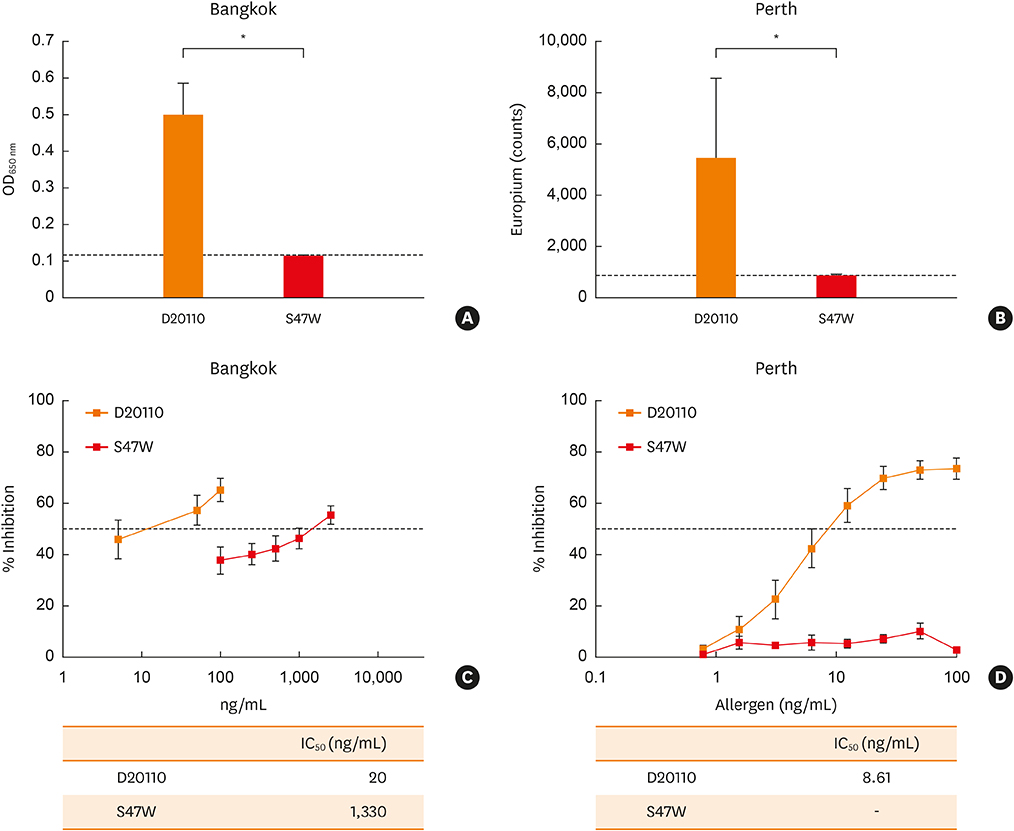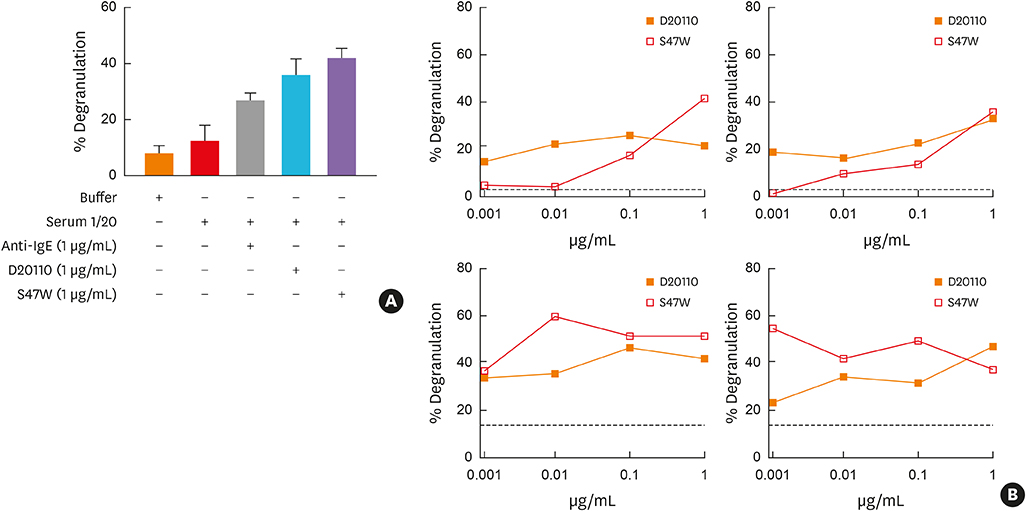Allergy Asthma Immunol Res.
2019 Jan;11(1):129-142. 10.4168/aair.2019.11.1.129.
Effects of Ser47-Point Mutation on Conformation Structure and Allergenicity of the Allergen of Der p 2, a Major House Dust Mite Allergen
- Affiliations
-
- 1Institute of Molecular Biosciences, Mahidol University, Salaya, NakornPathom, Thailand. piboons@gmail.com
- 2Department of Medicine, National Jewish Health, Denver, CO, USA.
- 3Department of Pediatrics, Faculty of Medicine Siriraj Hospital, Mahidol University, Thailand.
- 4Telethon Kids Institute, The University of Western Australia, Perth, WA, Australia.
- KMID: 2426791
- DOI: http://doi.org/10.4168/aair.2019.11.1.129
Abstract
- PURPOSE
Hypoallergenic recombinant Der p 2 has been produced by various genetic manipulations, but mutation of a naturally polymorphic amino acid residue known to affect IgE binding has not been studied. This study aimed to determine the effect of a point mutation (S47W) of residue 47 of Der p 2 on its structure and immunoglobulin (Ig) E binding. Its ability to induce pro-inflammatory responses and to induce blocking IgG antibody was also determined.
METHODS
S47 of recombinant Der p 2.0110, one of the predominant variants in Bangkok, was mutated to W (S47W). S47W secreted from Pichia pastoris was examined for secondary structure and for the formation of a hydrophobic cavity by 8-Anilino-1-naphthalenesulfonic acid (ANS) staining. Monoclonal and human IgE-antibody binding was determined by enzyme-linked immunosorbent assay. Allergen-induced degranulation by human epsilon receptor expressed-rat basophil was determined. Stimulation of the pro-inflammatory cytokine interleukin (IL)-8 release from human bronchial epithelial (BEAS2B) cells and inhibition of IgE binding to the wild type allergen by S47W-induced IgG were determined.
RESULTS
S47W reduced secondary structure and failed to bind the hydrophobic ANS ligand as well as a monoclonal antibody known to be dependent on the nature of the side chain of residue 114 in an adjacent loop. It could also not stimulate IL-8 release from BEAS2B cells. IgE from house dust mite (HDM)-allergic Thais bound S47W with 100-fold weaker avidity, whereas IgE of HDM-allergic Australians did not. S47W still induced basophil degranulation, although requiring higher concentrations for some subjects. Anti-S47W antiserum-immunized mice blocked the binding of human IgE to wild type Der p 2.
CONCLUSIONS
The mutant S47W had altered structure and reduced ability to stimulate pro-inflammatory responses and to bind IgE, but retained its ability to induce blocking antibodies. It thus represents a hypoallergen produced by a single mutation of a non-solvent-accessible amino acid.
MeSH Terms
-
Animals
Antibodies, Blocking
Asian Continental Ancestry Group
Basophils
Dust*
Enzyme-Linked Immunosorbent Assay
Humans
Immunoglobulin E
Immunoglobulin G
Immunoglobulins
Interleukin-8
Interleukins
Mice
Pichia
Point Mutation
Pyroglyphidae*
Antibodies, Blocking
Dust
Immunoglobulin E
Immunoglobulin G
Immunoglobulins
Interleukin-8
Interleukins
Figure
Reference
-
1. Vrtala S, Huber H, Thomas WR. Recombinant house dust mite allergens. Methods. 2014; 66:67–74.
Article2. Marth K, Focke-Tejkl M, Lupinek C, Valenta R, Niederberger V. Allergen peptides, recombinant allergens and hypoallergens for allergen-specific immunotherapy. Curr Treat Options Allergy. 2014; 1:91–106.
Article3. Derewenda U, Li J, Derewenda Z, Dauter Z, Mueller GA, Rule GS, et al. The crystal structure of a major dust mite allergen Der p 2, and its biological implications. J Mol Biol. 2002; 318:189–197.
Article4. Chen KW, Blatt K, Thomas WR, Swoboda I, Valent P, Valenta R, et al. Hypoallergenic Der p 1/Der p 2 combination vaccines for immunotherapy of house dust mite allergy. J Allergy Clin Immunol. 2012; 130:435–443.e4.
Article5. Asturias JA, Ibarrola I, Arilla MC, Vidal C, Ferrer A, Gamboa PM, et al. Engineering of major house dust mite allergens Der p 1 and Der p 2 for allergen-specific immunotherapy. Clin Exp Allergy. 2009; 39:1088–1098.
Article6. Smith AM, Chapman MD. Reduction in IgE binding to allergen variants generated by site-directed mutagenesis: contribution of disulfide bonds to the antigenic structure of the major house dust mite allergen Der p 2. Mol Immunol. 1996; 33:399–405.
Article7. Hakkaart GA, Aalberse RC, van Ree R. Epitope mapping of the house-dust-mite allergen Der p 2 by means of site-directed mutagenesis. Allergy. 1998; 53:165–172.
Article8. Smith AM, Chapman MD. Localization of antigenic sites on Der p 2 using oligonucleotide-directed mutagenesis targeted to predicted surface residues. Clin Exp Allergy. 1997; 27:593–599.
Article9. Reginald K, Chew FT. Conformational IgE epitope mapping of Der p 2 and the evaluations of two candidate hypoallergens for immunotherapy. Sci Rep. 2018; 8:3391.
Article10. Smith WA, Hales BJ, Jarnicki AG, Thomas WR. Allergens of wild house dust mites: environmental Der p 1 and Der p 2 sequence polymorphisms. J Allergy Clin Immunol. 2001; 107:985–992.
Article11. Piboonpocanun S, Malainual N, Jirapongsananuruk O, Vichyanond P, Thomas WR. Genetic polymorphisms of major house dust mite allergens. Clin Exp Allergy. 2006; 36:510–516.
Article12. Smith AM, Benjamin DC, Hozic N, Derewenda U, Smith WA, Thomas WR, et al. The molecular basis of antigenic cross-reactivity between the group 2 mite allergens. J Allergy Clin Immunol. 2001; 107:977–984.
Article13. Hales BJ, Hazell LA, Smith W, Thomas WR. Genetic variation of Der p 2 allergens: effects on T cell responses and immunoglobulin E binding. Clin Exp Allergy. 2002; 32:1461–1467.14. Park JW, Kim KS, Jin HS, Kim CW, Kang DB, Choi SY, et al. Der p 2 isoallergens have different allergenicity, and quantification with 2-site ELISA using monoclonal antibodies is influenced by the isoallergens. Clin Exp Allergy. 2002; 32:1042–1047.
Article15. Jeong KY, Lee IY, Yong TS, Lee JH, Kim EJ, Lee JS, et al. Sequence polymorphisms of Der f 1, Der p 1, Der f 2 and Der p 2 from Korean house dust mite isolates. Exp Appl Acarol. 2012; 58:35–42.
Article16. Tanyaratsrisakul S, Malainual N, Jirapongsananuruk O, Smith WA, Thomas WR, Piboonpocanun S. Structural and IgE binding analyses of recombinant Der p 2 expressed from the hosts Escherichia coli and Pichia pastoris . Int Arch Allergy Immunol. 2010; 151:190–198.17. Gray VE, Hause RJ, Fowler DM. Analysis of large-scale mutagenesis data yo assess the impact of single amino acid substitutions. Genetics. 2017; 207:53–61.18. Manček-Keber M, Jerala R. Structural similarity between the hydrophobic fluorescent probe and lipid A as a ligand of MD-2. FASEB J. 2006; 20:1836–1842.19. Österlund C, Grönlund H, Polovic N, Sundström S, Gafvelin G, Bucht A. The non-proteolytic house dust mite allergen Der p 2 induce NF-κB and MAPK dependent activation of bronchial epithelial cells. Clin Exp Allergy. 2009; 39:1199–1208.
Article20. Chiou YL, Lin CY. Der p2 activates airway smooth muscle cells in a TLR2/MyD88-dependent manner to induce an inflammatory response. J Cell Physiol. 2009; 220:311–318.
Article21. Mueller GA, Benjamin DC, Rule GS. Tertiary structure of the major house dust mite allergen Der p 2: sequential and structural homologies. Biochemistry. 1998; 37:12707–12714.
Article22. Mueller GA, Smith AM, Chapman MD, Rule GS, Benjamin DC. Hydrogen exchange nuclear magnetic resonance spectroscopy mapping of antibody epitopes on the house dust mite allergen Der p 2. J Biol Chem. 2001; 276:9359–9365.
Article23. Tanyaratsrisakul S, Jirapongsananuruk O, Kulwanich B, Hales BJ, Thomas WR, Piboonpocanun S. Effect of amino acid polymorphisms of house dust mite Der p 2 variants on allergic sensitization. Allergy Asthma Immunol Res. 2016; 8:55–62.
Article24. Christensen LH, Holm J, Lund G, Riise E, Lund K. Several distinct properties of the IgE repertoire determine effector cell degranulation in response to allergen challenge. J Allergy Clin Immunol. 2008; 122:298–304.
Article25. Trompette A, Divanovic S, Visintin A, Blanchard C, Hegde RS, Madan R, et al. Allergenicity resulting from functional mimicry of a Toll-like receptor complex protein. Nature. 2009; 457:585–588.
Article
- Full Text Links
- Actions
-
Cited
- CITED
-
- Close
- Share
- Similar articles
-
- Correlation between House Dust Mite Allergen Concentrations in Scalp Dander and Clinical Severity of Atopic Dermatitis in Children
- Effect of a Resident and Indoor Environmental Characteristics on the House Dust Mites Allergen
- Standardization of House Dust Mite Extracts in Korea
- The Effects of Storage Conditions on the Stability of House Dust Mite Extracts
- House Dust Mite Allergic Rhinitis Model in C57BL/6 Mice







